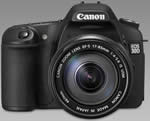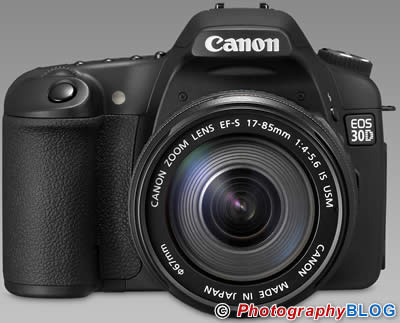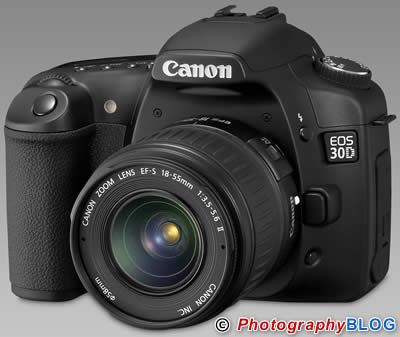Canon EOS 30D
 PMA 2006: The Canon EOS 30D is announced today. Improvements over the 20D include a 2.5 inch LCD, spot metering, Picture Style pre-sets and a few other minor tweaks. The Canon 30D will be available from March 2006, priced at body only £1099.99 / €1599.99, plus EF-S 18-55mm f/3.5-5.6 (non USM) lens £1179.99 / €1749.99.
PMA 2006: The Canon EOS 30D is announced today. Improvements over the 20D include a 2.5 inch LCD, spot metering, Picture Style pre-sets and a few other minor tweaks. The Canon 30D will be available from March 2006, priced at body only £1099.99 / €1599.99, plus EF-S 18-55mm f/3.5-5.6 (non USM) lens £1179.99 / €1749.99.
Canon UK Press Release
Canon upgrades best selling EOS 20D
Canon is pleased to announce the new EOS 30D, replacing the award winning EOS 20D. Retaining the 5fps, 8.2 Megapixel performance of its predecessor, the upgraded camera enjoys a larger, wider viewing angle 2.5” LCD, extended 100,000 shutter cycle durability, spot metering, and a variety of refinements designed to enhance the photographic experience. Targeted at an increasingly discerning population of serious creative photographers, the Canon 30D replaces a camera that already claims a significant share of the Western Europe D-SLR market, which grew by 120% in the past 12 months. “A rapidly expanding population of serious and semi-commercial creative photographers is helping drive EOS growth,” said Mogens Jensen, Head of Canon Consumer Imaging Europe. “As well as putting many high-end pro features into their hands, the EOS 30D becomes a launching pad into the world’s most comprehensive interchangeable lens system and huge range of flash units and accessories.”
The EOS 30D features:
- 8.2 Megapixel APS-C size CMOS sensor
- 5fps and 30 large JPEG frame burst
- 2.5”, 230K pixel, 170º wide viewing angle LCD screen
- Picture Style image processing parameters
- Spot metering and High Precision 9-point AF system
- DIGIC II image processor with 0.15 sec start-up time
- Digital Photo Professional RAW processing software
- 100,000 cycle shutter durability and rugged magnesium alloy body
- Simultaneous RAW and JPEG recording
- Wide 100-3200 ISO range
- E-TTL II Flash
- PictBridge compatibility
- Complete compatibility with all Canon EF and EF-S lenses and EX-series Speedlites
- USB 2.0 Hi-Speed and Video Out connectivity
Improved performance
Many improvements on the EOS 20D are made in response to EOS 20D owner feedback. Along with the larger screen, improved durability and 3.5% area spot metering, these include Canon’s Picture Style pre-sets, Canon’s in-camera image processing standard. Picture Styles can be likened to selectable film types for different photographic expression (see appendix ‘Technologies Explained’). Frame rate is selectable between 5 and 3fps and photographers are given finer control over exposure, with ISO settings now adjustable by 1/3 stop increments rather than whole stops. A Print/Share button is included and the camera features new advanced PictBridge functionality. The maximum number of images in a folder is increased from 100 to 9,999, while the in-built flash has been upgraded to match the 100,000 shutter cycle durability, an increasingly important feature in the digital age.
Speed and image quality
The EOS 30D features Canon’s award winning CMOS sensor technology, with large 6.4µm2 pixels for wide dynamic range with low noise. Any remaining fixed pattern and random noise is dealt with by on-chip noise elimination circuitry. A low-pass filter in front of the sensor reduces false colour and moiré effects, while an infrared filter suppresses red fringing caused by sensor reflections and fog. The camera features Canon’s DIGIC II processor now found across the digital EOS range. DIGIC II maximises speed and image quality by processing uncompromisingly complex colour rendition algorithms, clearing the buffer at high speed. (For more on CMOS and DIGIC II, see appendix ‘Technologies Explained).
EOS: The system
One of the EOS 30D’s greatest advantages is the EOS system: compatibility with all Canon EF and EF-S lenses, EX-series Speedlites and EOS accessories such as the Wireless File Transmitter WFT-E1. The EOS 30D’s EF-S lens mount allows connection to Canon’s range of lighter and wider angle lenses, including the new wide aperture EF-S 17-55mm f/2.8 IS USM standard zoom lens. Indicative of Canon’s commitment to lens development is the release today of the exceptionally fast EF 85mm f/1.2L II USM, for low light and extremely narrow depth of field photography. For high-speed processing of lossless RAW images and complete capture-to-print workflow management, the EOS 30D also comes with Canon’s latest Digital Photo Professional software (see appendix ‘Technologies Explained).
Battery grip
To extend the EOS 30D’s 750 shot battery life and increase handling options, the camera is compatible with the BG-E2 battery grip. The BG-E2 takes two Lithium-Ion battery packs for up to 2,200 frames or six AA batteries in the supplied BGM-E2 battery magazine. For easy vertical shooting, the BG-E2 provides additional shutter release, main dial, AE lock/FE lock and AF point selection controls.
EOS Range
Canon’s current EOS range now includes:
- EOS-1Ds Mark II - 16.7 Megapixels, 4 fps
- EOS-1D Mark II N - 8.2 Megapixels, 8.5 fps
- EOS 5D - 12.8 Megapixels, 3 fps
- EOS 30D - 8.2 Megapixels, 5fps
- EOS 350D - 8.0 Megapixels, 3fps
Software
As well as the latest Digital Photo Professional RAW image processing software, the EOS 30D comes with Canon EOS Solution Disk, containing the new EOS Utility (integrating remote capture software), plus the latest versions of ZoomBrowser/ImageBrowser and PhotoStitch.
The EOS 30D includes membership of Canon’s online photo album, CANON iMAGE GATEWAY with 100MB of space for image uploads and photo sharing .
Pricing and availability
The EOS 30D will be available from March 2006, priced at:
EOS 30D body only:
£1099.99 RRP inc. VAT/ €1599.99 RRP inc. VAT
EOS 30D plus EF-S 18-55mm f/3.5-5.6 (non USM) lens:
£1179.99 RRP inc. VAT/ €1749.99 RRP inc. VAT.
Technologies Explained
Picture Style
Picture Style pre-sets simplify in-camera control over image quality. Picture Style pre-sets can be likened to different film types – each one offering a different colour response. Within each easily selectable pre-set, photographers have control over sharpness, contrast, colour tone and saturation. The camera’s factory default configuration is set to deliver immediately-usable JPEG images without need for additional menu settings. Picture Style presets applied to a RAW image do not degrade the image in any way and can be revised with Canon’s Digital Photo Professional software.
The six pre-sets include: Standard – for crisp, vivid images that don’t require post-processing; Portrait – optimises colour tone and saturation and weakens sharpening to achieve attractive skin tones; Landscape – for punchier greens and blues with stronger sharpening to give a crisp edge to mountain, tree and building outlines); Neutral – ideal for post-processing; Faithful – adjusts colour to match the subject colour when shot under a colour temperature of 5200K; Monochrome – for black and white shooting with a range of filter effects (yellow, orange, red and green) and toning effects (sepia, blue, purple and green). The User Defined pre-set can be used to store up to three customised pre-sets, or any of the pre-sets available for download from Canon’s web site.
DIGIC II
Now found across the EOS range, DIGIC II is a purpose built, dedicated image processor responsible for the high speed calculations necessary in order to providing exceptionally accurate colour reproduction in real time. Canon’s second generation imaging engine, DIGIC II performs the duties of a number of separate processing units to speed processing, save space, and optimise battery life.
To avoid the trade off faced by other manufacturers between camera responsiveness and image quality, Canon has created a processor so fast it can read, process, compress and write image data back to the buffer between exposures. This allows for longer continuous bursts at maximum frame rates before the buffer fills. Moreover, each image can be subjected to the full complex processing algorithms required in order to deliver superb image quality.
CMOS
Canon’s award winning CMOS technology is one of the company’s key competitive advantages. With noise reduction circuitry at each pixel site, Canon’s CMOS sensors have lower noise and lower power consumption characteristics than CCD sensors.
CCD sensors use a bucket relay system to transfer each pixel’s accumulated electrical charge to a corresponding gutter. The operation is time consuming and draws considerable power, which limits battery life and generates unwanted heat, further increasing noise and lowering image quality.
By contrast, signal conversion in Canon’s CMOS sensors is handled by the individual amplifiers at each pixel site. Unnecessary charge transfer operations are avoided, vastly speeding up the process of getting signal to the image processor. Noise generation is reduced and power consumption limited.
Digital Photo Professional Software
Digital Photo Professional software provides high-speed processing of lossless RAW images. Processing with Digital Photo Professional allows real-time display and immediate application of image adjustments, giving control over RAW image variables such as white balance, dynamic range, exposure compensation and colour tone. The camera JPEG images can be recorded in sRGB or Adobe RGB colour space, and the Digital Photo Professional application supports sRGB, Adobe RGB and Wide Gamut RGB colour spaces. An ICC (International Colour Consortium) profile attaches automatically to RAW images converted to TIFF or JPEG. This allows faithful reproduction of colours in software applications that support ICC profiles, such as Adobe Photoshop. For improved efficiency, a set of image adjustments can be saved as a reciepe and applied to multiple images.
About Canon (UK) Limited
Canon is a world-leading innovator and provider of imaging and information technology solutions for the home and office environments.
Canon has a global philosophy of Kyosei - living and working together for the common good, which clearly demonstrates commitment to customers, staff and the environment shared by all.
Canon (UK) Ltd is the UK marketing and sales operation for the US$33 billion global company based in Tokyo, Japan. In the UK Canon employs over 2,000 people in various locations including Ireland and has achieved sales of £522m in 2004.
The main business focus for Canon (UK) Ltd, covers two clearly defined market segments: Business Solutions covering both the office and professional printing environments (including: multifunctional printers, IT consultation and peripherals: photocopiers, printers, fax machines, document management hardware & software, multimedia LCD projectors) and Consumer Imaging (input solutions: film and digital cameras, camcorders, binoculars and scanners; and output solutions: Ink Jet printers, fax machines, desktop multifunctionals and multimedia projectors).
Product specifications: EOS 30D
IMAGE SENSOR
Type 22.5 x 15.0mm CMOS
Effective Pixels Approx. 8.2M
Total Pixels Approx. 8.5M
Aspect Ratio 3:2
Low-Pass Filter Built-in/Fixed
Colour Filter Type Primary Colour
IMAGE PROCESSOR
Type DIGIC II
LENS
Lens Mount EF/EF-S
Focal Length 1.6x Multiplication with EF lens fitted
FOCUSING
Type TTL-CT-SIR with a CMOS sensor
AF System/ Points 9-point AF
AF working range EV -0.5-18 (at 20°C & ISO100)
AF Modes AI Focus
One Shot
AI Servo
AF Point Selection Automatic selection, Manual selection
Selected AF point display Superimposed in viewfinder and indicated on top LCD panel
Predictive AF Yes
AF Lock Locked when shutter button is pressed half way in One Shot AF mode.
AF Assist Beam Intermittent firing of built-in flash
Manual Focus Selected on lens
EXPOSURE CONTROL
Metering modes TTL full aperture metering with 35 zone SPC
(1) Evaluative metering (linked to any AF point)
(2) Partial metering (approx. 9% of viewfinder at centre)
(3) Spot metering:
Centre spot metering (approx. 3.5% viewfinder at centre)
(4) Centre weighted average metering
Metering Range EV 1-20 (at 20°C with 50mm f/1.4 lens ISO100)
AE Lock Auto: Operates in 1-shot AF mode with evaluative metering when focus is achieved
Manual: By AE lock button in creative zone modes.
Exposure Compensation +/- 2 EV, 1/2 or 1/3-stop increments
AEB +/- 2 EV, 1/2 or 1/3-stop increments
ISO Speed Equivalent 100-1600 (in 1/3-stop increments) ISO can be expanded to H: 3200 (selected in Custom Function)
SHUTTER
Type Electronically-controlled focal-plane shutter
Speed 30-1/8000 sec (1/2 or 1/3 stop increments), Bulb.
Shutter release Soft touch electromagnetic release
WHITE BALANCE
Type Auto white balance with the imaging sensor
Settings AWB, Daylight, Shade, Cloudy, Tungsten, White
Fluorescent light, Flash, Custom, Colour Temperature Setting.
White balance compensation: 1. Blue/Amber +/-9
2. Magenta/ Green +/-9.
WB Bracketing +/-3 stops in full stop increments
3 bracketed images per shutter release.
Selectable Blue/Amber bias or Magenta/ Green bias.
COLOUR MATRIX
Type Two types of colour space, sRGB and Adobe RGB.
VIEWFINDER
Viewfinder Pentaprism
Coverage (Vertical/Horizontal) Approx. 95%
Magnification 0.9x (4)
Eyepoint 20mm
Dioptre Correction -3 to +1 dpt
Focusing Screen Fixed
Mirror Quick-return half mirror (Transmission: reflection ratio of 40:60, no mirror cut-off with EF600mm f4 or shorter)
Viewfinder Information AF information (AF points, focus confirmation light), exposure information (shutter speed, aperture value, ISO speed, AE lock, exposure level/compensation, spot metering circle, exposure warning, AEB), flash information (flash ready, high-speed sync, FE lock, flash exposure compensation), white balance correction, AF confirmation, CF card information
Depth of field preview Yes
LCD MONITOR
Monitor 2.5” TFT, approx. 230,000 pixel
Coverage Approx. 100% (for JPEG images)
Brightness Adjustable to one of five levels
FLASH
Modes Auto, Manual Flash On/Off, Red-Eye Reduction
HotShoe/ PC terminal Yes/ Yes
X-sync 1/250sec
Red-eye Reduction Yes
Flash Exposure Compensation +/- 2EV in 1/2 or 1/3 increments
Flash Exposure Bracketing Yes
Flash Exposure Lock Yes
Second Curtain Synchronisation Yes
Built-in Flash Range Coverage up to 17mm focal length (27mm equivalent)
Guide Number (ISO 100, meters) 13
External Flash E-TTL II with EX series Speedlites,
wireless multi-flash support
SHOOTING
Modes Auto, Portrait, Landscape, Close-up, Sports, Night Portrait, No Flash, Program AE, Shutter priority AE, Aperture priority AE, Manual, A-DEP
Photo Effects Monochrome (selected from the “Picture Style” menu) with options for Filters and Toning Effects.
Drive modes Single/ Continuous L/ Continuous H
Continuous Shooting Max. Approx. 5fps. (speed maintained for up to 30 images (JPEG)(1), 11 images (RAW)) (2)
RECORDING PIXELS / COMPRESSION
Image Size (LF) 3504x2336, (LN) 3504x2336, (MF) 2544x1696, (MN) 2544x1696, (SF) 1728x1152, (SN) 1728x1152, (RAW) 3504x2336
Compression Fine, Normal, RAW (Canon RAW 2nd edition)
FILE FORMAT
Still Image Format JPEG (Exif 2.21 [Exif Print] compliant) / Design rule for Camera File system (2.0), Digital Print Order Format [DPOF] Version 1.1 compliant
RAW+JPEG simultaneous recording Yes
File Numbering (1) Consecutive numbering
(2) Auto reset
(3) Manual reset
Processing Parameters 6 Preset ‘Picture Styles’ with 3 User defined settings
DIRECT PRINT
Canon Printers Canon Compact Photo Printers and PIXMA Printers supporting PictBridge
PictBridge Yes
OTHER FEATURES
Custom Functions 19 Custom Functions with 53 settings
LCD Panel (EL) Illumination Yes
Water/ Dust resistance No
Sound Memo No
Intelligent Orientation Sensor Yes
Histogram Brightness: Yes
RGB: Yes
Playback zoom 1.5x - 10x
Display Formats (1) Single image with information
(2) Single image
(3) 9 image index
(4) Magnified view
Image Erase Protection Erase protection of one image at a time
Image Erase Single image, All
Self Timer Approx. 10 sec.
Menu Categories (1) Shooting Menu
(2) Playback menu
(3) Setup menu
Menu Languages English, German, French, Dutch, Danish, Finnish, Italian, Norwegian, Swedish, Spanish, Simplified Chinese, Japanese, Traditional Chinese, Korean, Russian
Firmware Update Update possible by the user.
INTERFACE
Computer USB 2.0 Hi-Speed (Mini-B, PTP)
Other Video output (PAL/ NTSC)
MEMORY CARD
Type CompactFlash Type I / II (Microdrive compatible)(3)
SUPPORTED OPERATING SYSTEM
PC Windows 98SE / 2000 / Me / XP
Macintosh OS X v10.2 to v10.4
SOFTWARE
Browsing & Printing ZoomBrowser EX / ImageBrowser
Other PhotoStitch, EOS Utility (inc. Remote Capture)
Drivers TWAIN (Windows 98/2000), WIA (Windows Me/XP)
Image Manipulation Digital Photo Professional (Windows 2000 / XP)
POWER SOURCE
Batteries Rechargeable Li-ion Battery BP-511/BP-511A or BP-512/BP-514 (BP-511A battery supplied), 1xCR2016 for date & settings
Battery life Approx. 750 (at 20°C, AE 50%, FE 50%) (5)
Approx. 600 (at 0°C, AE 50%, FE 50%)
Battery check Automatic
Power saving Power turns off after 1, 2, 4, 8, 15 or 30mins.
A/C Power Supply Optional, Power adapter AC-EK2
ACCESSORIES
Case Semi-Hard case EH17-L
Lenses All EF and EF-S lenses
Flash Canon Speedlites (220EX, 380EX, 420EX, 430EX, 550EX, 580EX, Macro-Ring-Lite, MR-14EX, Macro Twin Lite MT-24EX, Speedlite Transmitter ST-E2)
Battery Grip BG-E2
Remote Controller/ Switch Remote control with N3 type contact
Power Supply & Battery Chargers AC Adapter Kit ACK-E2, Compact power adapter CA-PS400, Battery charger CB-5L, Battery charger CG-570, Car Battery Cable Kit CR-560, BP-511A
PHYSICAL SPECIFICATIONS
Body Materials Magnesium Alloy/Plastic
Operating Environment 0 – 40 °C, 85% or less humidity
Dimensions (WxHxD) 144 x 105.5 x 73.5mm
Weight (body only) Approx. 700g
1 Large/Fine resolution
2 Depending on memory card speed / capacity
3 Compatible with all memory card capacities, including cards of 2GB and more
4 with 50mm lens at infinity, -1 dpt
5 Based on the CIPA Standard and using the batteries and memory card format supplied with the camera, except where indicated
* Product specifications subject to change without notice


